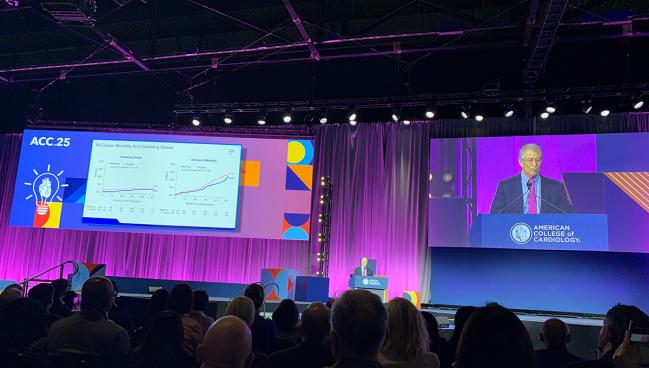Evolut Low Risk Trial: TAVI Holds Up to Surgery at 5 Years
The follow-up brought little surprise, with investigators pleased the risk of death/disabling stroke remained on par with surgery.

CHICAGO, IL—Five-year follow-up for patients with severe aortic stenosis and low surgical risk affirm the benefits of TAVI with a self-expanding, supra-annular valve compared with surgery, according to the latest data from the Evolut Low Risk trial.
The combined rates of death and disabling stroke were similar in both groups, as was the individual endpoint of disabling stroke, with no difference seen between years 4 and 5, said senior study author Michael J. Reardon, MD (Houston Methodist Hospital, TX), presenting the results here at the American College of Cardiology (ACC) 2025 Scientific Session. The findings were simultaneously published in the Journal of the American College of Cardiology.
For Reardon, the CV mortality endpoint is particularly important to focus on.
“Cardiovascular mortality should have some relationship to how well we relieve aortic stenosis and the actual performance of the valve,” he said in a meeting with the media prior to the presentation.
At 5 years, the rate of CV mortality was 9.3% in the SAVR patients versus 7.2% in the TAVI patients (log-rank P = 0.15). That 2.1% difference in CV mortality is almost double the 1.1% difference seen at the 2 years, and “gives me great confidence that Evolut is remaining a very safe and effective way of treating aortic stenosis versus surgical valves in a similar population,” said Reardon.
Nonetheless, the trial will continue to track patients for 10 years, follow-up that he said is important to have in order to be fully confident in the durability of TAVI in low-risk patients.
Gilbert H.L. Tang, MD (Mount Sinai Health System, New York, NY), a cardiovascular surgeon, said all signs point to the self-expanding valve platform performing well in low-risk patients.
“The valve performance remains excellent. The incidence of valve thrombosis and reintervention rate remains low. So, I think that’s what we can tell our patients with confidence at least in terms of 5 years,” he said. ”We don’t have 10 years. We do in high-risk patients with NOTION and other trials, but at least in this particular age group and risk profile, we can be reassured. That being said, we still recommend that people get annual surveillance to make sure that the valve is still performing well.”
Jasmina Katinic, DNP (HCA Florida Healthcare, St. Petersburg), commenting during the press conference, said she was encouraged to see no differences in the Kansas City Cardiomyopathy Questionnaire (KCCQ) overall summary scores between groups.
“What is actually excellent to see [is] that the patients also feel better in the 5-year period, and the TAVR patients actually start to feel better at 30 days as well,” she noted.
Evolut Low Risk at 5 Years
The trial, which was conducted at 86 sites in Australia, Canada, France, Japan, the Netherlands, New Zealand, and the US, randomized 1,414 patients (mean age 74 years; 35% women) with severe aortic stenosis and a risk of death from surgery of less than 3% based on a heart team evaluation. The mean STS score was 2.0% in the TAVI arm and 1.9% in the surgery group. Patients were implanted with CoreValve, Evolut R, or Evolut PRO (n = 730; Medtronic) or underwent surgery with a bioprosthetic valve (n = 684).
The 5-year rate of all-cause mortality or disabling stroke (primary endpoint) was 15.5% for the TAVI group and 16.4% for the SAVR group (P = 0.47). All-cause mortality was 13.5% with TAVI and 14.9% with SAVR (P = 0.39). Disabling stroke occurred in 3.6% and 4.0% (P = 0.57). Rates of noncardiovascular death were 6.8% and 6.2%, respectively (P = 0.73).
In a separate analysis that excluded patients who were lost to follow-up or withdrew from the study, the mortality rate was 14.7% for TAVI and 15.2% for SVAR (P = 0.74).
Clinical valve thrombosis and subclinical valve thrombosis rates were low and similar with the two treatments, at 0.3% versus 0.2% (P = 0.61) and 0.6% versus 0.5% (P = 0.81), respectively. Additionally, the rates of surgical or transcatheter valve reintervention were no different, at 3.3% for TAVI and 2.5% for surgery (P = 0.44).
Echocardiographic outcomes favored TAVI, with lower mean aortic valve gradient and larger mean effective orifice area. Mild or greater aortic valve regurgitation was seen in 17.0% of TAVI patients and 5.7% of SAVR patients. Paravalvular leak of mild or greater was seen in 14% and 0.5%, respectively (P < 0.001).
Finally, rates of patients who were alive and well (KCCQ summary score > 75) were similar at approximately 70% in each group.
Pacemakers and Other Questions
One thing that has remained consistent throughout the 5 years of this trial is the higher rate of new pacemaker in the TAVI patients. By 5 years, 27% who did not have a pacemaker at baseline needed one, as compared with 11.3% of the SAVR group (P < 0.001).
Tang noted that it was reassuring to see that despite a much greater need for pacemaker, it did not confer a negative impact in terms of morbidity or mortality, something he said patients do sometimes ask about when told of the possibility of needing one after TAVI.
“The good news is now we have two studies showing 5-year data in this population subset [with TAVI] noninferior to surgery,” noted Juan Granada, MD (Cardiovascular Research Foundation, New York, NY), commenting in the late-breaking trial session.
He questioned what needs to be done in future trials in terms of things like patient selection or technique to get rates of pacemaker and paravalvular leak closer to surgical outcomes.
Reardon said the cusp overlap method already shows signs of having made a difference in pacemaker rates, although it was not used in the Evolut Low Risk trial. Additionally, he said many patients coming in for TAVI have an existing right bundle branch block where a pacemaker has been deferred because the patient is referred for TAVI.
“I put in my TAVR and 66% of those people get a pacemaker, and if I operate on them, their risk of pacemaker is pretty high,” Reardon said. “[But] having a new pacemaker versus no new pacemaker at 30 days does not affect your 5-year mortality.”
To TCTMD, Tang said streamlining of the TAVI technique is an ongoing and evolving process that is improving paravalvular leak because operators are being more proactive about trying to avoid it. “Overall, the procedure has become more efficient and more predictable,” he said. “Every technical modification and procedural improvement is a win for the patient.”
L.A. McKeown is a Senior Medical Journalist for TCTMD, the Section Editor of CV Team Forum, and Senior Medical…
Read Full BioSources
Forrest JK, Yakubov SJ, Deeb GM, et al. 5-year outcomes after transcatheter or surgical aortic valve replacement in low-risk patients with aortic stenosis. J Am Coll Cardiol. 2025;Epub ahead of print.
Disclosures
- Reardon reports research grants from Abbott, Boston Scientific, WL Gore Medical, and Medtronic.





Comments